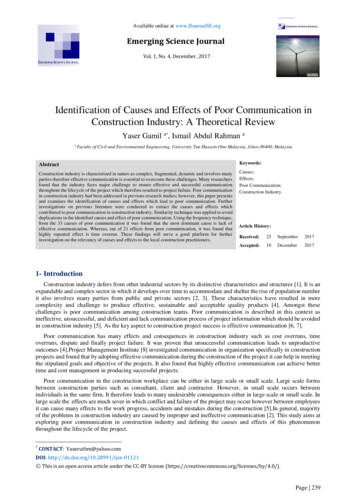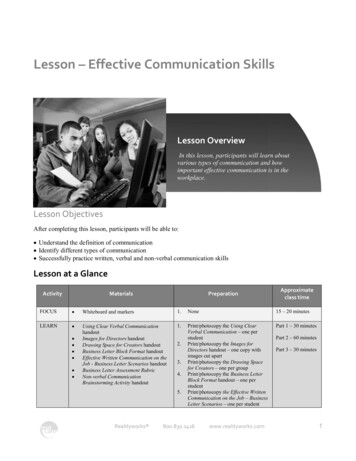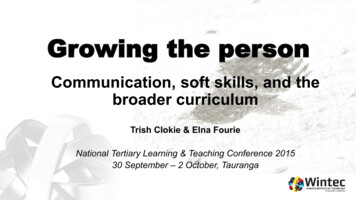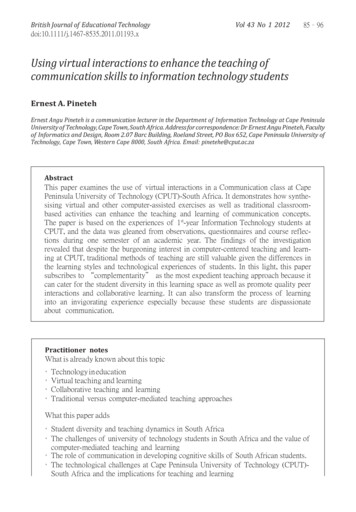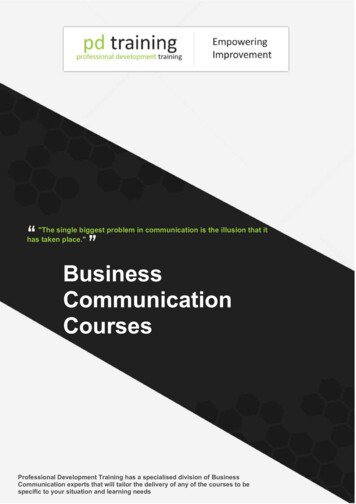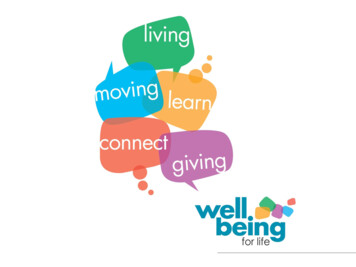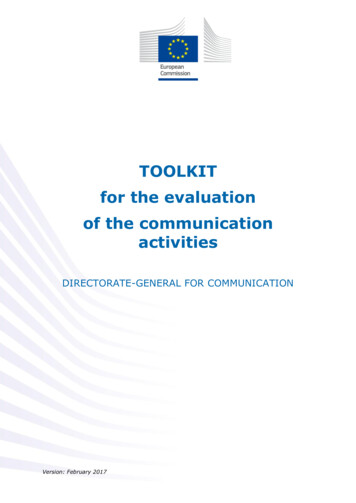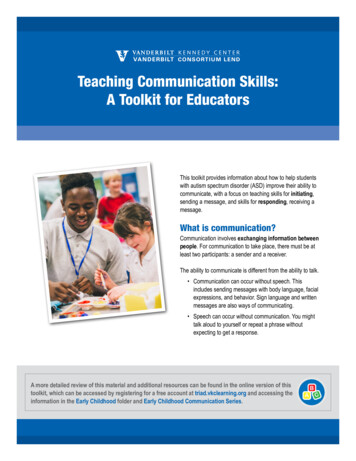
Transcription
Teaching Communication Skills:A Toolkit for EducatorsThis toolkit provides information about how to help studentswith autism spectrum disorder (ASD) improve their ability tocommunicate, with a focus on teaching skills for initiating,sending a message, and skills for responding, receiving amessage.What is communication?Communication involves exchanging information betweenpeople. For communication to take place, there must be atleast two participants: a sender and a receiver.The ability to communicate is different from the ability to talk. Communication can occur without speech. Thisincludes sending messages with body language, facialexpressions, and behavior. Sign language and writtenmessages are also ways of communicating. Speech can occur without communication. You mighttalk aloud to yourself or repeat a phrase withoutexpecting to get a response.pageA more detailed review of this material and additional resources can be found in the online versionContinuedof this on nextBtoolkit, which can be accessed by registering for a free account at triad.vkclearning.org and accessing theA Cinformation in the Early Childhood folder and Early Childhood Communication Series.
PicturesCommunication comes in many forms.ReadPlaying ballPlay gameGAME Spoken words–Use of words or phrases Signs or sign language–A formal system of handgestures with specific meaningsSpoken Words Gestures–Hand or body actions Sounds or vocalizations–Use of non-word soundsor vocal noises Facial expressions–Movements of the eyes, nose,or mouth Pictures–A visual method using photographs thatrepresent vocabulary Line drawings–A visual method using drawingsthat represent objects or vocabulary actions Written words–For example, through a note or sign Physical behaviors–Behaviors such as runningaway, leading someone by the hand, givingsomeone an object, or turning away Aggressive behaviors–Behaviors such as pushingor hitting another person Eye gaze–Using eye contact or a gaze toward aperson or object Echolalia–Echoing or repeating back someoneelse’s words Augmentative and Alternative Communication(AAC)–Any communication other than verbalspeechenvironment, orthe person’s physical andemotional state.When students with ASD struggle with communicationor respond to others in a way that is different thanexpected, it is often rooted in the core characteristics ofASD: differences in social communication and restrictedor repetitive behaviors. More information about ASD canbe found at triad.vkclearning.org.Communication is a process, or a series of steps,carried out to achieve a goal. The process ofcommunication starts with a desire to communicate, or aneed to be met.We can use the ABC framework to understand thewhy of communication. The ABC framework stands forAntecedent, Behavior, and Consequence.Understanding this framework can also help us set upsituations that may result in increased communicationfrom students.These forms of communication range from concrete,such as throwing a tantrum, to abstract, such as spokenlanguage. A person’s communication skills may differdepending on the situation, what else is going on in theMOREINFOSee examples of the ABC frameworkin the online version of this toolkitreferenced on page one.ABC FrameworkAntecedentBehaviorConsequenceWhat happens right beforethe communicative behaviorGoal-directed actionsto send and respond tomessagesWhat happens right after thecommunicative behaviorPage 2 Teaching Communication Skills: A Toolkit for Educators
Why teach communication? Being able to communicate with others is anessential skill across settings. Communication isimportant for expressing wants, needs, feelings,and emotions. It is important for interacting withothers and building relationships. Communicationskills are important at school, at home, and in thecommunity. Difficulty communicating plays a role in manychallenging behaviors. If students have a need anddon’t know an appropriate way to communicatefor it, they may use less socially appropriate waysof getting that need met. Teaching communicationskills can help reduce and prevent challengingbehaviors. Teaching communication opens up opportunitiesfor students. The more a student is able tocommunicate, the more successful socialinteractions they will be able to have, which inturn create more opportunities for learning andpracticing communication skills. Teaching communication also increaseseducational opportunities and students’ abilityto participate in different settings. The more astudent is able to communicate and respondto others independently, the more able theywill be to participate in a variety of educationalenvironments.Deciding what to teachThe first step in teaching communication is decidingwhat communication skill to teach. It is important to useyour student’s current communication skills as a startingplace. Your ultimate goal for your student might be tocommunicate like his or her peers, or to communicatein an age- or grade-appropriate way. However, whenchoosing a communication skill to teach, think about thebest next step.The best next step for your student could be: A replacement behaviorfor a challengingbehavior, such asteaching a student totouch a break card orsay “no” instead ofhitting others when shewants an activity to end.I Need ABreak The best nextdevelopmental step,such as expanding thestudent’s current formof communication to another setting or teachinga new communication method. For example, if astudent touches objects to request them, a nextstep might be to teach the student to use picturesof objects to make requests. A functional skill to be used at school or home,such as teaching a student to ask for help, ask fora break, or answer a teacher’s question.Teaching Communication Skills: A Toolkit for Educators Page 3
Teaching InitiatingWhen we teach initiating, we are teaching a studentto start an interaction. To teach initiating, we need toanswer three questions:1. What will motivate this student tocommunicate?What is motivating to your student will depend on hisor her unique wants, needs, and interests. In general,students communicate to access or escape items,activities, or attention. For example, a student mightbe motivated to communicate when he or she wantsor needs help, wants an object but cannot accessit independently, does not want to continue doingan activity, or needs a break from an overwhelmingsituation.With a student’s motivations in mind, you can setup the environment to increase opportunities for astudent to initiate communication. Some strategies forsetting up the environment include: “Sabotage”–Ask or tell students to do somethingthat you know they will need help with. Forexample, place materials in a container theycannot open without help. Out-of-reach placement–Place items where studentscan see them but have to askfor them. For example, storematerials in your desk or on ashelf higher than your studentscan reach.Forgetfulness–“Forget”necessary items for an activityso students must requestthem. For example, “forget” to put outdry erase markers after handing out dry eraseboards.Once you have set up something in the environmentto motivate your student to communicate, it isimportant to be close by so you can respondimmediately when he or she initiates! It is alsoimportant to intentionally wait to give your studentsthe chance to initiate on their own.2. What behavior will we teach this student touse?When choosing a behavior to teach, remember tothink about the best next step, as described onpage 3. The best next step will depend on yourstudent’s current skills.3. How will we respond to the student’scommunication?Your response to the student’s communicationdepends on how the student initiates. We will respondin one of two ways: If the student uses the goal behavior, reinforce itimmediately. If the student does not use the goal behavior,provide a prompt, or cue, to help them movecloser to the goal behavior. Once the studentuses, or comes closer to using, the goal behavior,provide the reinforcement.MOREINFO Novelty–Add something new and interesting toyour classroom so students will comment or askabout it. For example, bring a new or unusualdecoration into the classroom.For more information on usingprompts effectively, choosing themost appropriate prompt for yourstudent, and providing reinforcement,see the online version of this toolkitreferenced on page one.Once you have identified the antecedent that willmotivate your student, the behavior you want to teach,and the consequence or response you will provide–you are ready to embed communication opportunitiesthroughout the day by:1. Setting up the situation2. Waiting for the student to initiate3. Providing reinforcement or a promptSee page five for an example of this process.Page 4 Teaching Communication Skills: A Toolkit for Educators
Example of teaching initiating: Ciara is a pre-school student who is not yet using words. When shewants a snack, she tries to get it herself. Her teacher wants Ciara to point to request what she wants.Her teacher puts snacks in containers Ciara cannot open. She holds two containers out of Ciara’s reach.When Ciara reaches toward a snack, her teacher gives her some. Over time, her teacher uses modelingand physical prompts to help Ciara come closer to pointing.AntecedentBehaviorConsequenceTeacher holdssnack containers out ofCiara’s reachCiara points to a snackTeacher gives Ciarasome snackTeaching RespondingThe difference between initiating and responding to communication is what comes before the communication.Students initiate communication when they are motivated or interested in doing so. When a student responds tocommunication, he or she is reacting to someone else’sinitiation. Successful responding relies on your abilityto initiate communication with your student in the mosteffective way possible.Just as in teaching initiating, there are three questions toanswer when teaching a student to respond.1. How will you initiate?Think about what you want your student to respondto. In school, students are often expected to respondwhen an adult gives a direction, asks a question, ormakes a comment. This section focuses on teachingstudents to respond to adult initiations; however,similar strategies can be used when teachingcommunication with peers.Initiating in an effective way increases the chances ofthe student responding successfully. Here are somestrategies for initiating effectively: Limit distractions. Especially when a student is firstlearning a skill, practice at a calm time. Move closer to the student to make sure yourstudent can see and hear you. Get the student’s attention by saying his or hername, catching his or her gaze, or tapping him orher on the arm. Use the least number of words possible to give thedirection or ask the question. For example, insteadof “Let’s use walking feet,” say “Please walk.” Pair your initiation with a visual support, such asan object or picture that clarifies what the studentis supposed to do.MOREINFOFor more information on visualsupports, see the Visual Supportsonline training at triad.vkclearning.org.2. What response will we teach the studentto use?As with teaching initiating, the behavior you teachwill depend on your individual student. Remember tothink about the best next step.Teaching Communication Skills: A Toolkit for Educators Page 5
3. How will we respond to the student’scommunication?As in teaching initiating, if the student uses the goalbehavior, reinforce it immediately. If the student doesnot use the goal behavior, first provide a prompt andthen provide reinforcement when he or she comescloser to using the goal behavior.Note: When teaching initiating, the reinforcementwas directly related to the student’s goal forcommunicating. For example, if a studentcommunicates to request a snack, the naturalreinforcement is receiving the snack. When teachingresponding, the student may not be as motivated tocommunicate for the natural reinforcer. You may needto provide some extra reinforcement, such as specificpraise, allowing them to earn a prize, or giving them atoken towards a larger goal.Once you have answered these three questions–theantecedent or initiation that will be provided, thebehavior you want to teach, and the consequenceor response you will provide–you are ready to teachthe communication skill by:1. Initiating2. Waiting for the student to respond3. Providing reinforcement or a promptSee below for an example.Example: Christopher is a sixth grade student who speaks in full sentences. He follows one-stepinstructions but needs support to complete multi-step instructions given to the whole class. His teacherwould like to help him independently follow multi-step directions. The teacher creates a visual supportlisting the materials Christopher needs for math class. When it is time for math, the teacher standsnear Christopher, says “Get ready for math,” places the visual on his desk, and waits for Christopher torespond. If he needs an extra prompt, the teacher taps the visual.AntecedentBehaviorConsequenceTeacher places a visualsupport on Christopher’sdesk and gives an instructionto the classChristopherdoes not respondTeacher gestures toChristopher’s visual supportWhen Christopher responds to the prompt by getting out his math materials, the teacher provides specificpraise and a high-five.AntecedentBehaviorConsequenceTeacher gestures toChristopher’s visual supportChristopher gets out hismath materialsTeacher provides specificpraise and a high fivePage 6 Teaching Communication Skills: A Toolkit for Educators
ConclusionRemember, an important part of teaching communicationskills is deciding on the best next step for your student.Once you decide on a skill to teach, you will beready to use the information in this toolkit to set upthe environment for success, wait for your student’scommunication, and then prompt or reinforce theirresponse to help them be successful.MOREINFOIf you are interested in learningmore about teaching communicationskills, please see the full onlineTeaching Communication toolkit byvisiting triad.vkclearning.org. Otherresources on this website providemore information about visualsupports, reinforcement, echolalia,and other topics.ResourcesVisit triad.vkclearning.org for resources, information, and brief trainings related to autism spectrumdisorder and evidence-based practices. Online trainings have been developed for educators andcaregivers on topics including educational practices, mental health needs, and more.If you are interesting in learning more about teaching communication skills, the following trainings andresources are available at triad.vkclearning.org, under the School-Age Services (K-12) category. Building Blocks of Communication Visual Supports Reinforcement in the ClassroomThe following webinars are also available about this topic at triad.vkclearning.org under WebinarRecordings. Communication Plain and Simple Webinar Series The Social Communication Skills Network (TSCSN) Webinar Series Early Childhood Communication Webinar SeriesFinally, the following printable resources that go into more detail about topics covered in this toolkit areavailable at triad.vumc.org/resources Autism Spectrum Disorders Tip Sheet Visual Supports and Autism Spectrum DisordersTeaching Communication Skills: A Toolkit for Educators Page 7
This publication was authored by Laura Corona, PhD, LEND (Leadership Education in Neurodevelopmental Disabilities) andTRIAD (Treatment and Research Institute for Autism Spectrum Disorders) fellow; Whitney Loring, PsyD, Assistant Professor ofPediatrics and Psychiatry & Behavioral Sciences, TRIAD Assistant Director of Training, and TRIAD Families First Coordinator;and Kristin Dorris, MS, CCC-SLP, TRIAD Educational Consultant.This toolkit was edited, designed, and produced by the Dissemination and Graphics staff of the Vanderbilt Kennedy Center forExcellence in Developmental Disabilities. This publication may be distributed as is or, at no cost. View more printable resourcesand materials online at: vkc.vumc.org.This project is supported by the Health Resources and Services Administration (HRSA) of the U.S. Department of Healthand Human Services (HHS) under grant number T73MC30767, Vanderbilt Consortium LEND. This information or contentand conclusions are those of the authors and should not be construed as the official position or policy of, nor should anyendorsements be inferred by HRSA, HHS or the U.S. Government. May 2019
Teaching communication skills can help reduce and prevent challenging behaviors. Teaching communication opens up opportunities for students. The more a student is able to communicate, the more successful social interactions they will be able to have, which in turn create more opportunities for learning and practicing communication skills.
